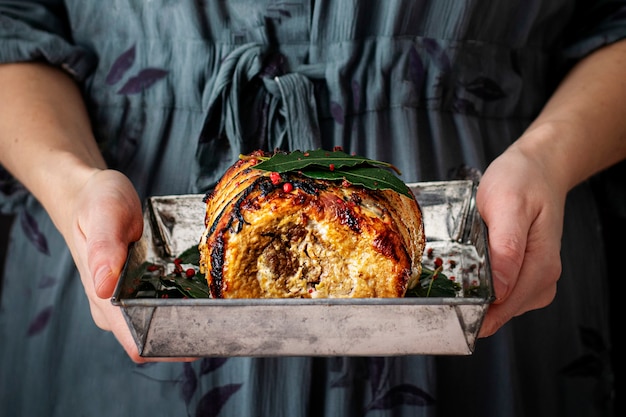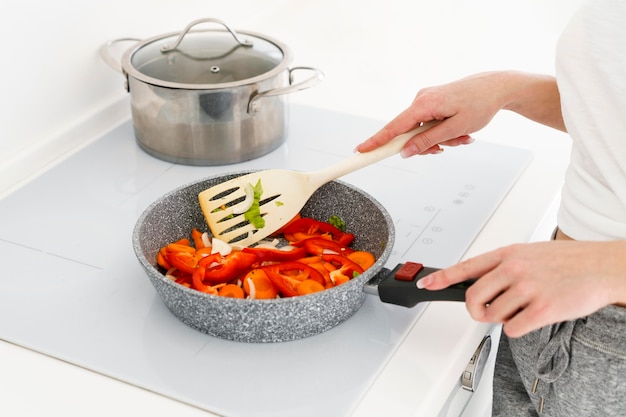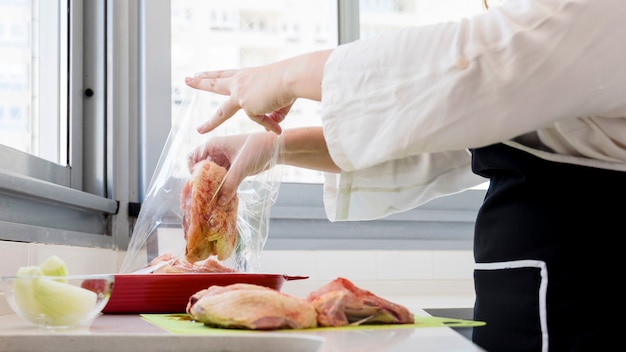There's something truly magical about cracking open a juicy, succulent crab leg. The sweet, briny taste of fresh crab meat, especially when cooked to absolute perfection, is a culinary experience that's hard to beat. But let's be honest, achieving that perfect "just right" texture with crab legs can be a bit of a culinary puzzle. You don't want them dry and rubbery, and you definitely don't want them undercooked. Over the years, I've found myself on a mission to master the art of cooking crab legs, and the foil method has become my absolute go-to. This method consistently delivers the most delicious, tender, and flavorful results, and I'm excited to share my secrets with you. So grab your aprons, folks, because we're about to embark on a culinary adventure!
Part 1: The Importance of Freshness

Let's face it, the foundation of any great seafood dish lies in the quality of the ingredients. Freshness is key. When it comes to crab legs, I always make a beeline for my local fishmonger. They're the experts, and their knowledge is invaluable. I love chatting with them about the latest catches and getting their advice on choosing the best crab legs. They'll guide you to the plumpest legs, the ones with a delightful, fresh scent, and a good, firm bounce. These are the telltale signs of top-notch crab legs that will make your taste buds sing.
While fresh is always preferred, if you're working with frozen crab legs, you can still achieve fantastic results. Just be sure to defrost them properly. I prefer to defrost them overnight in the refrigerator, but a cold-water bath can be a good alternative if you need them sooner.
Choosing Your Crab Legs
Here's a quick rundown of what to look for when selecting your fresh crab legs:
- Firmness: Think of a good crab leg as a bouncy castle for your taste buds! It should be firm to the touch and spring back slightly when you press it. If it feels soft or mushy, move on.
- Color: Imagine a vibrant sunset on the ocean. That's the color you want to see in your crab legs. A bright, reddish-orange shell is a sign of freshness. If it's faded or dull, the crab leg might be past its prime.
- Smell: This is one of the most crucial elements. A fresh crab leg will have a clean, almost briny scent. If you detect a fishy or ammonia-like smell, it's best to steer clear.
- Weight: A heavy leg generally indicates a plumper, more meaty crab, which is always a good thing!
Part 2: Preparing the Crab Legs

Now that you have your pristine crab legs, it's time to give them a little pre-oven pampering. Don't worry, it's a simple process, but it makes a big difference. First things first, I always rinse my crab legs thoroughly under cold running water to remove any excess salt or debris. This ensures a clean canvas for the flavors to shine through.
Part 3: Creating the Flavor Base

Here's where the real magic begins! The foil method is all about creating a mini steamy sauna for your crab legs, and that's where the magic happens. It's a culinary symphony of flavors! I start with a layer of melted butter. Because, let's be real, who doesn't love a little buttery goodness? Then, I add a sprinkle of garlic powder, onion powder, paprika, and a pinch of salt and pepper. This combination is my go-to, but the beauty of this method is the endless possibilities for customization. You can add a dash of old bay seasoning for a classic Chesapeake Bay vibe, a pinch of cayenne pepper for a touch of heat, or a squeeze of lemon juice for a bright, tangy flavor. The world is your oyster, or rather, your crab leg!
Part 4: The Foil Envelopment
Now comes the fun part: the foil magic! I always opt for heavy-duty aluminum foil because it's strong enough to hold all those delicious juices and flavors. I fold it in half to create a large sheet, then I place my crab legs in the center, making sure to leave some space for them to steam. Then, I drizzle the melted butter mixture over the crab legs, ensuring they're coated evenly. Finally, I fold the foil over the crab legs, tightly sealing the edges to create a tight, steam-proof package. Make sure to crimp the edges well so that no precious steam escapes. This will create that perfect, moist environment for your crab legs to cook to perfection.
Part 5: Baking Time!
Get ready to put those ovens to work! I preheat my oven to 350°F (175°C) and place the foil packet directly on a baking sheet. The baking time will depend on the size of your crab legs, but typically, it takes around 20-25 minutes. But don't worry, we're not leaving it to chance! You can check for doneness by carefully opening one of the foil packets and poking the thickest part of the crab leg with a fork. If the meat is opaque and flakes easily, you're ready to feast! If it's still translucent, give it a few more minutes. Remember, every oven has its own personality, so always check on those crab legs towards the end of the cooking time to ensure they're perfectly cooked.
Part 6: The Big Reveal
Here comes the moment you've been waiting for... the big reveal! Carefully lift the foil packet from the oven and place it on a cutting board. Let the steam escape for a few minutes before carefully opening the foil. The aroma that hits you is intoxicating. It's like a symphony of fresh seafood and buttery goodness. It's a truly sensory experience that will have you craving more.
Part 7: Serving Up a Seafood Feast
Get ready to savor the fruits (or rather, the legs) of your labor! Serve the crab legs piping hot and fresh from the oven. You can even use the delicious juices from the foil packet as a dipping sauce. It's a rich, flavorful broth that elevates the entire experience. I love to serve my crab legs with a generous helping of melted butter, lemon wedges, and a side of crusty bread for soaking up all the juices. Don't forget those napkins, because these bad boys can get messy, and you wouldn't want to miss out on a single drop of that deliciousness!
Tips for Serving Crab Legs:
Here are a few tips to make your crab leg feast even more enjoyable:
- Crackers: Provide your guests with a variety of crackers, like oyster crackers or Triscuits, to help them break open those crab legs.
- Tools: Crab leg crackers and picks are essential for extracting that delicious meat.
- Gloves: If you're concerned about messy fingers, provide disposable gloves for your guests. It's a practical touch that keeps the focus on the deliciousness.
- Presentation: Serve your crab legs on a large platter with a bowl of melted butter for dipping. You can add a decorative touch with lemon slices or fresh herbs. It's all about that visual appeal!
- Sides: Round out your crab leg feast with a variety of side dishes, such as corn on the cob, creamy coleslaw, or a classic potato salad. These side dishes complement the crab legs beautifully and offer a delightful balance of flavors.
Part 8: The Beauty of Leftovers
Let's be honest, sometimes you just can't resist the allure of a good crab leg feast. And sometimes, that leads to leftovers. But don't fret! leftover crab legs are just as delicious as the fresh ones. You can store them in an airtight container in the refrigerator for up to 3 days. To reheat them, simply place them in a preheated oven at 350°F (175°C) for about 10 minutes, or until heated through. You can also reheat them in the microwave, but they won't be as flavorful. A bit of leftover crab meat can also be used in salads, sandwiches, or even pasta dishes.
Part 9: Experimenting with Flavors
One of the things I love most about cooking crab legs in the oven is the endless possibilities for flavor combinations. While I love my classic butter and garlic recipe, I'm always eager to try new things. Here are a few of my favorite flavor adventures:
Flavor Combinations to Try
- Lemon Herb: Add a tablespoon of chopped fresh herbs, like parsley, dill, or thyme, to the butter mixture. Squeeze a lemon over the crab legs before wrapping them in foil. This combination is a burst of fresh, vibrant flavors that perfectly complements the crab.
- Spicy Cajun: Add a tablespoon of Cajun seasoning and a pinch of cayenne pepper to the butter mixture. For an extra kick, drizzle a bit of hot sauce over the crab legs before serving. This is for those who like a little heat in their lives, and it adds a fantastic depth of flavor.
- Asian-Inspired: Use a mixture of soy sauce, ginger, garlic, and sesame oil for a flavorful twist. It's a unique combination that adds a touch of Asian flair to your crab leg feast.
- Mediterranean: Combine olive oil, garlic, lemon juice, and oregano for a fresh and aromatic flavor. This combination is a celebration of the Mediterranean flavors, bright and full of character.
The beauty of cooking is experimentation. Don't be afraid to get creative and try new things. You might just discover your new favorite flavor combination!
Part 10: FAQs
You've got questions, and I've got answers! Here are some common questions about cooking crab legs in the oven.
- How do I know if crab legs are cooked?
A properly cooked crab leg will have opaque, flaky meat. If you poke it with a fork, the meat should flake easily. It's a good indication that the crab legs have reached that perfect, tender state.
- What if the crab legs are overcooked?
Overcooked crab legs will be tough and rubbery. If you suspect your crab legs might be overcooked, try soaking them in cold water for a few minutes to help them rehydrate. This can help to restore some of the moisture and tenderness.
- Can I freeze cooked crab legs?
Yes, you can freeze cooked crab legs. Place them in an airtight container or freezer bag and freeze for up to 3 months. To reheat them, thaw them in the refrigerator overnight and then reheat them in the oven or microwave. While it's best to enjoy them fresh, freezing them allows you to enjoy the deliciousness of crab legs at a later date.
- What happens if I don't wrap the crab legs in foil?
If you skip the foil wrapping, your crab legs will dry out in the oven. The foil creates a steamy environment that keeps the crab legs moist and flavorful. It's the key to achieving that perfect, juicy texture.
- What other methods can I use to cook crab legs?
Crab legs can also be cooked in a variety of other ways, including steaming, boiling, and grilling. However, the foil method is one of the easiest and most reliable ways to cook them at home, and it consistently delivers fantastic results.
Everyone is watching

Prime Rib Roast Cooking Time Chart: Per Pound Guide
Cooking TipsPrime rib roast. Just the name conjures images of lavish dinners, crackling fires, and hearty laughter. It’s ...

How Long to Bake Potatoes in the Oven (Perfect Every Time)
Cooking TipsBaked potatoes are a staple in my kitchen. They're incredibly versatile, delicious, and surprisingly easy to m...

Perfect Rice Every Time: The Ultimate Guide to Cooking Rice
Cooking TipsAs a self-proclaimed foodie, I've always been a bit obsessed with rice. It's the foundation of countless cuisi...

The Ultimate Guide to Cooking Asparagus: Tips, Techniques, and Recipes
Cooking TipsAsparagus. The mere mention of this spring delicacy conjures up images of vibrant green spears, crisp and burs...

Ultimate Guide to Cooking the Perfect Thanksgiving Turkey
Cooking TipsThanksgiving. Just the word conjures up images of overflowing tables laden with delicious food, the scent of r...
